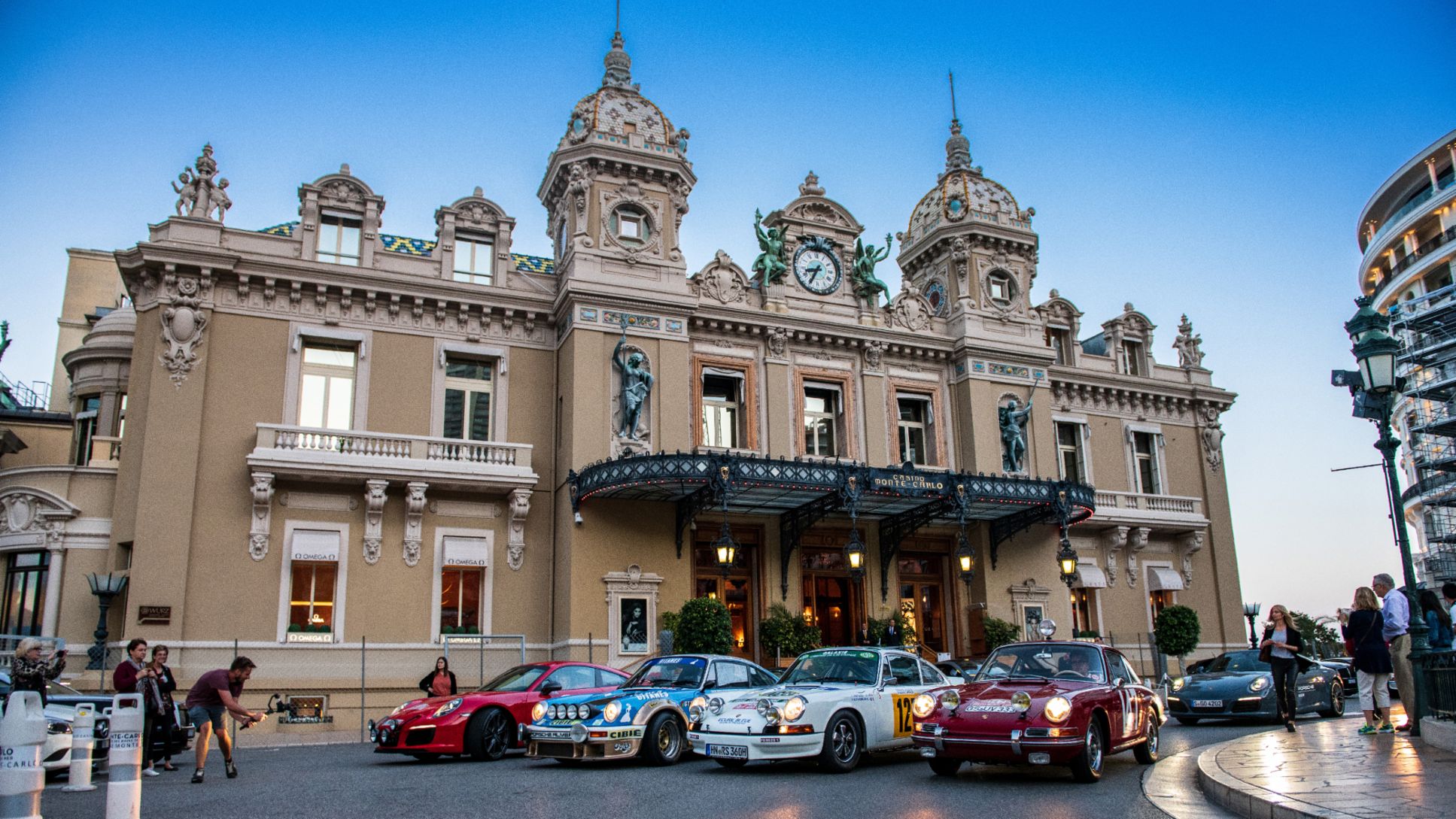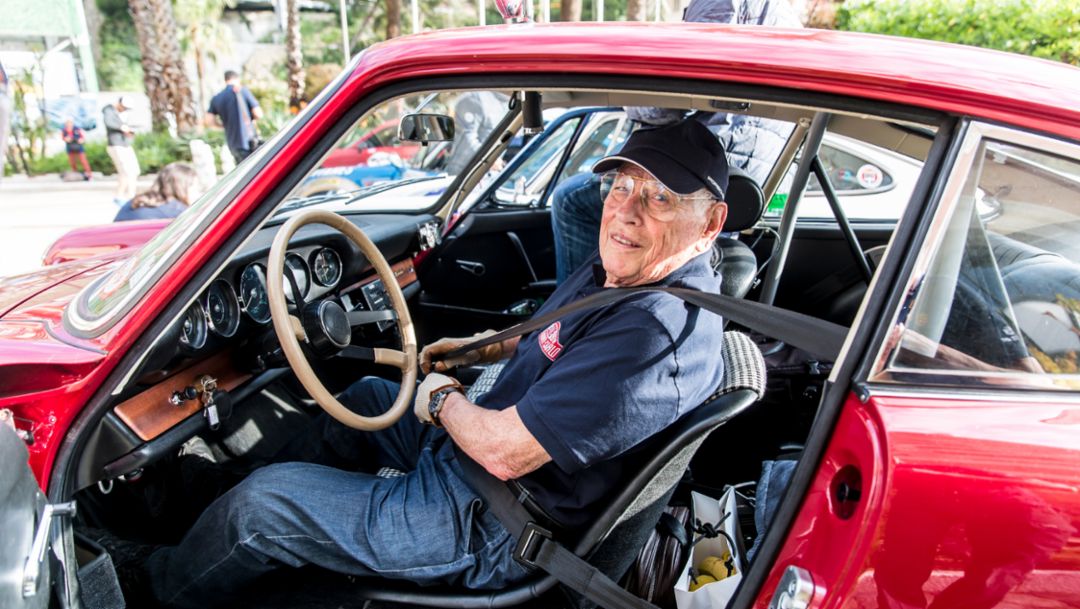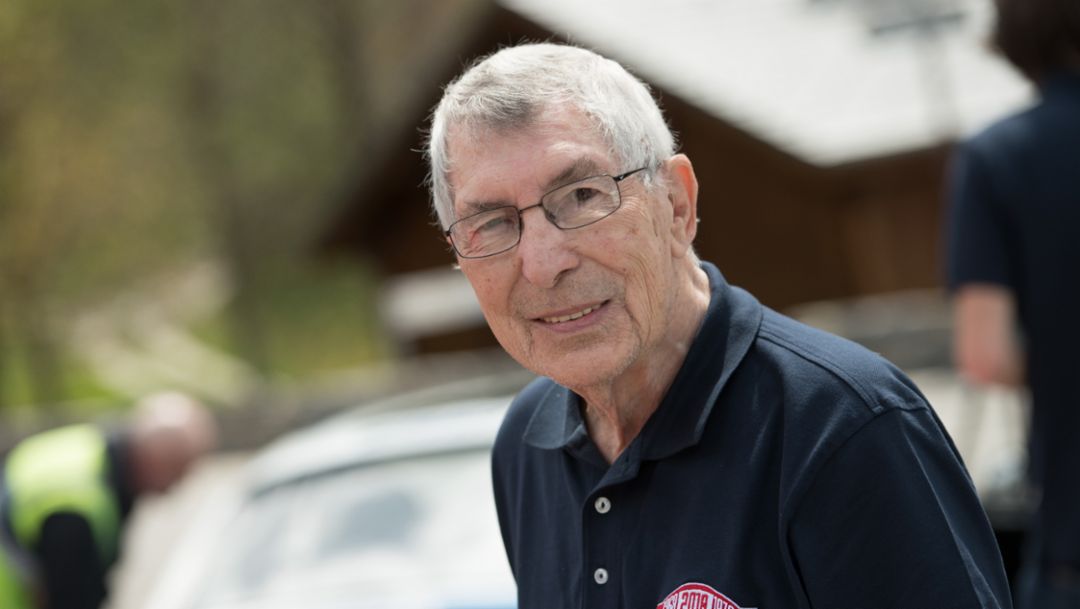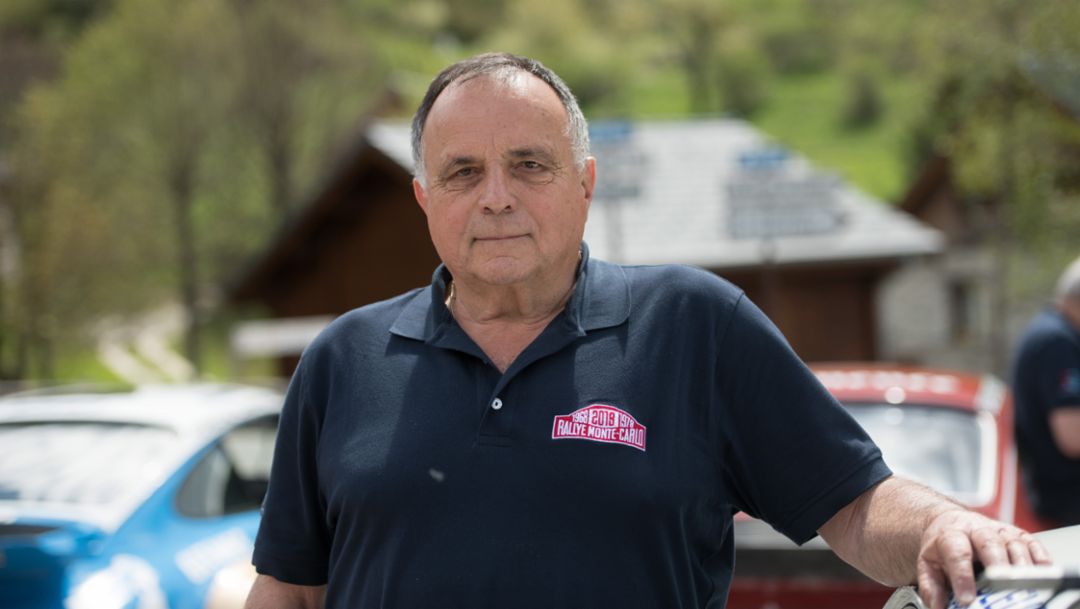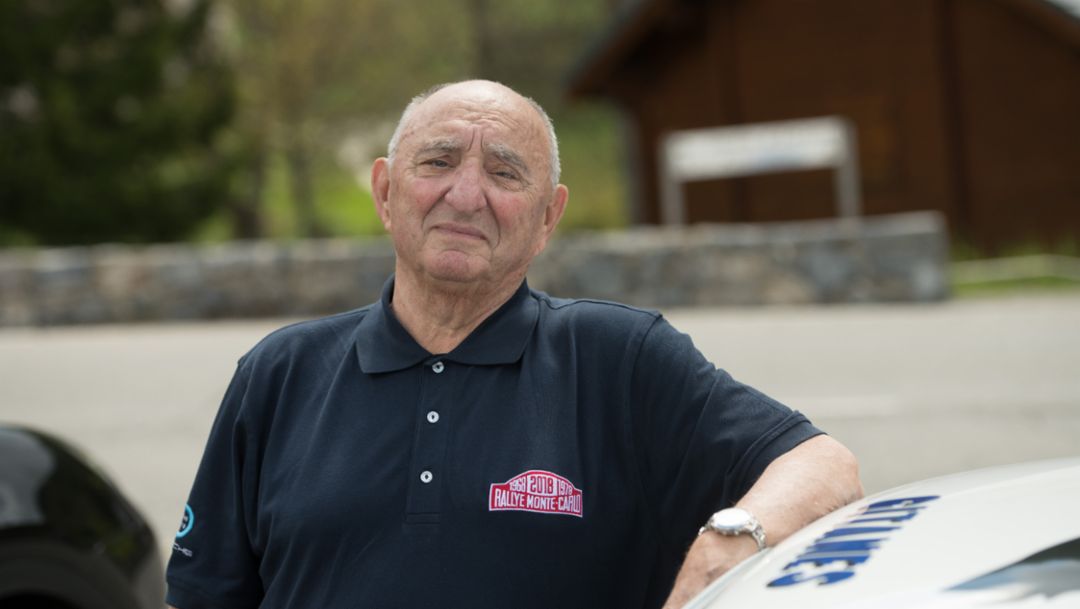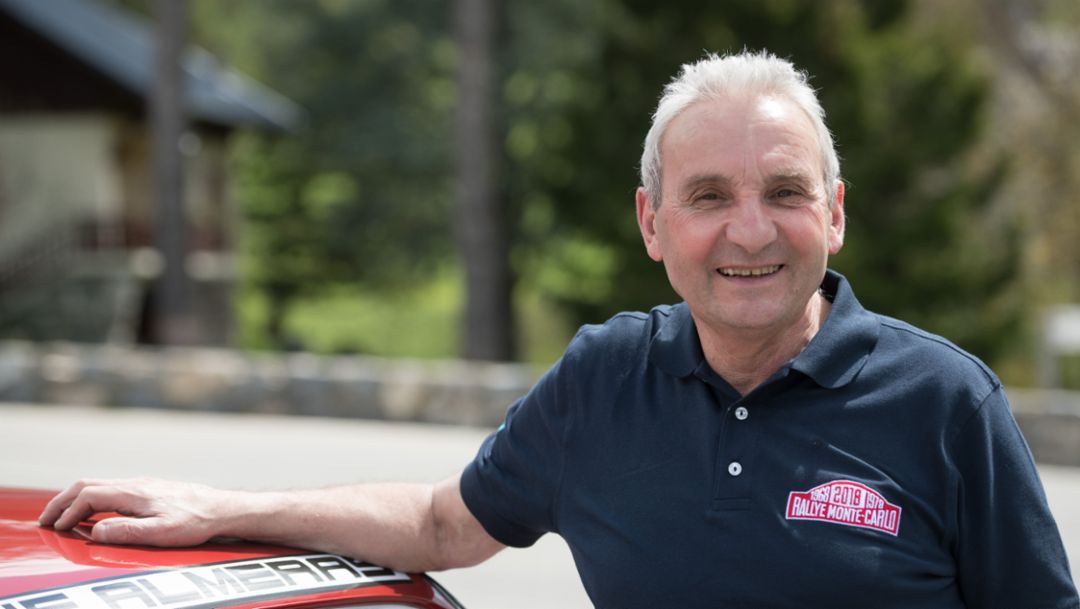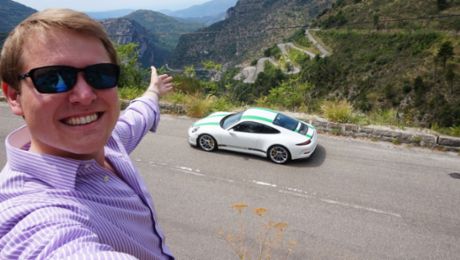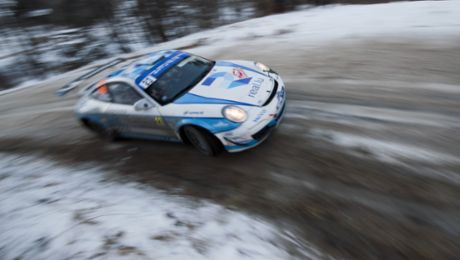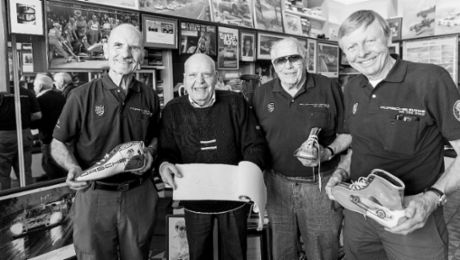Herbert Linge and the 901/911 2.0 Coupé
Herbert Linge, Weissach veteran and former test and racing driver, is undoubtedly the first of Porsche’s Monte Carlo heroes. “For marketing purposes, all I had to do was take an early 911 and just arrive in one piece – end of story”, he recalls as he drives the original car through the mountains. In fact, former race director Huschke von Hanstein actually only wanted proof of the long-distance capability of the 356-successor and a marketable photo of 911 fan and car enthusiast Prince Rainier of Monaco following the race through the Alps. Linge and his co-driver Peter Falk were given the car with the chassis number 300055, which the engineers had only superficially prepared for the ordeal: 150 instead of 130 hp, Weber rather than Solex carburettor, different stabilisers, five-speed manual transmission, a slightly back-offset shift lever, a roof lamp for highlighting signs, Twinmaster, stopwatches, additional front headlights, cage, a step bar at the rear plus leather belts to allow for better traction over the rear axle. Linge had the steering wheel coated with leather – and it was ready to go.
The team began that year’s Monte Carlo Rally from the departure point in Bad Homburg. “From the Eifel mountains, everything was covered with snow – but since I had done all the winter tyre tests on the 356 vehicles, it didn’t matter”, says Linge, laughing. When they arrived in the principality in the 901/911, Linge and Falk were completely surprised to discover that they were ranked eighth overall. During the “night of the long knives” at the infamous Col de Turini, the two put in another powerful performance, taking 5th place in the overall standings. And they delivered the car undamaged as requested. From 2013 to 2015, it was restored by the team at Porsche Classic and now belongs to a private German collector.
Vic Elford and the 911 Carrera T
Porsche works driver Vic Elford still had a bone to pick with the Monte Carlo Rally: Due to an inaccuracy in the rules, he had missed out on victory in 1967. And so “Quick Vic” and his co-driver David Stone started the race in Warsaw in a 170-hp 911 T weighing less than a ton. Following the first stage, Frenchman Gérard Larrousse in his Alpine occupied first place at the starting line in front of the Monte Carlo casino with a 14-second advantage – directly followed by Elford/Stone. The Briton drove like mad and took a 20-second lead over Larrousse. Larrousse didn’t give up and chased after him, but had the bad luck of encountering the work of some dubious jokers on the pass: some spectators had shovelled snow on the road. Larrousse slid, and his Alpine veered into a wall. Elford was victorious.
Still today, Elford can talk for hours about the events surrounding that rally. He is driving the 2018 911 Carrera T in Monte Carlo Rally trim: “The best car I have ever driven in my life”, he says – a high accolade indeed for the red coupé. This tribute vehicle features reminiscences of the victorious 911, including additional headlights, rear mud flaps, Halda rally instruments, carbon-weave finish full bucket seats and the years “1968” (passenger side) and “2018” (driver side) embroidered on the headrests. And to anticipate any questions: it remains a one-off example and is not for sale.
René Rochebrun and the 911 Carrera 2.7 RS
After Porsche also won the Monte Carlo Rally in 1969 and 1970 in the 911 (taking the runners-up spot each time) and then withdrew from the competition, private teams began clamouring for the lightweight racing cars from Zuffenhausen. “As a private entity, what you need most of all is passion”, explains René Rochebrun, who once worked as a sales representative in the meat industry. He was co-driver for Jean Jacques Santucci. The pair arrived at the Monte Carlo Rally in 1978 in a white Porsche 911 2.7 RS from 1972, which started off in Group 3 for standard GT vehicles in a very good 17th place overall.
He now drives the original racing car – but now occupying the driver’s seat – and still remembers exactly how it felt back then: “We were practically at the front and it made us feel very important. But in reality we played only a small part”. The mechanics were friends who shared their passion, and during the very few breaks in the long rally Rochebrun had to organise his professional and private life, in addition to tasks such as eating, sleeping in the racing shell and dealing with sponsors.
Rochebrun remained involved with motorsport until 1987, including as co-driver for actor and amateur racing driver Jean-Louis Trintignant. The white, 210-hp 911 – incidentally, the second 2.7 RS ever delivered to France – spent 45 years passing between French racing drivers before a German finally secured the car.
Jean-Pierre Nicolas and the 911 Carrera RS 3.0
In 1978, exactly ten years after the first 911 victory in the Alps, 216 cars took part in the Monte Carlo Rally – 29 of which were Porsche. Under the starting number 3, French rally specialist Jean-Pierre Nicolas and his co-driver Vincent Laverne, who had replaced one Jean Todt, put the pedal to the metal. The car was a 911 Carrera 3.0 – wide, strong, and loud. The World Rally Champion (both as driver and team manager) had not forgotten how to drive fast, gleefully racing the fire-spitting 250-hp racing car along the narrow mountain roads. “Only 15 days before the start of the rally, we got the budget from Gitane”, he yells over the flat engine. “And we were able to borrow the Alméras car”. Based in Montpellier, Jean-Marie and Jacques Alméras built the hottest 911 racing cars of the time – this car had a group 4 chassis and a group 3 engine, which was much softer in the snow than a group 4 powertrain.
The competition at the Monte Carlo Rally was as illustrious as it was strong – for example, a certain Walter Röhrl drove in the works Fiat. But Nicolas hung them all out to dry – and won with a lead of two minutes. And so, exactly ten years after the first victory, a 911 once again graced the centre of the podium. Restored in 2008, the car today belongs to Spanish racing team Teo Martín Motorsport.
Jacques Alméras and the 911 3.0 Group 4
Probably no-one knows more about the rally Porsche vehicles of the 1970s than Jacques Alméras: Back then, he built them with his brother Jean-Marie. Including the red 330-hp Porsche 3.0 Group 4 from 1974, which he enjoys driving, albeit rarely. In this vehicle, he became the French mountain champion in the “GT Special” class in 1974.
His greatest joy is to chase down Nicolas. The two have known each other almost 50 years and have only driven against each other once – at the Tour de France rally in 1974. Today, the car still gives him a real feeling of being at a rally – not just because he can still make the car fly, but because he is relying on instructions from his co-driver and wearing a headset with “Mickey Mouse” ears and microphone in front of his mouth. He can easily answer the question as to why France has such a long-standing rally tradition, as he sticks to Nicolas’s rear bumper: “It’s quite simple: The country has always loved motorsport. Geographically, it offers the ideal conditions for rallies, particularly in the southeast, where there are technically very demanding routes. In terms of climate, they have a lot of snow in winter and dry Mediterranean weather in summer.”
